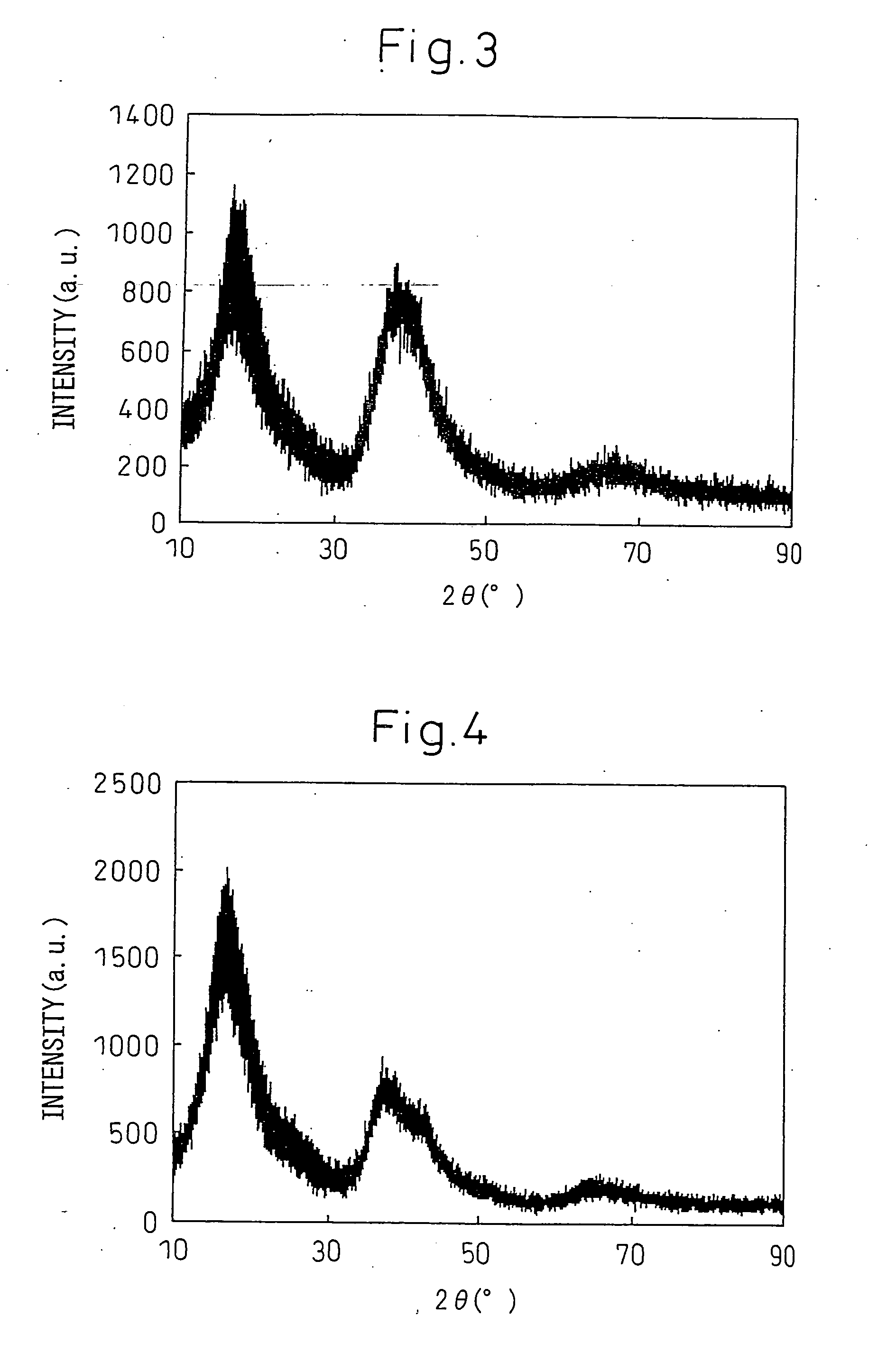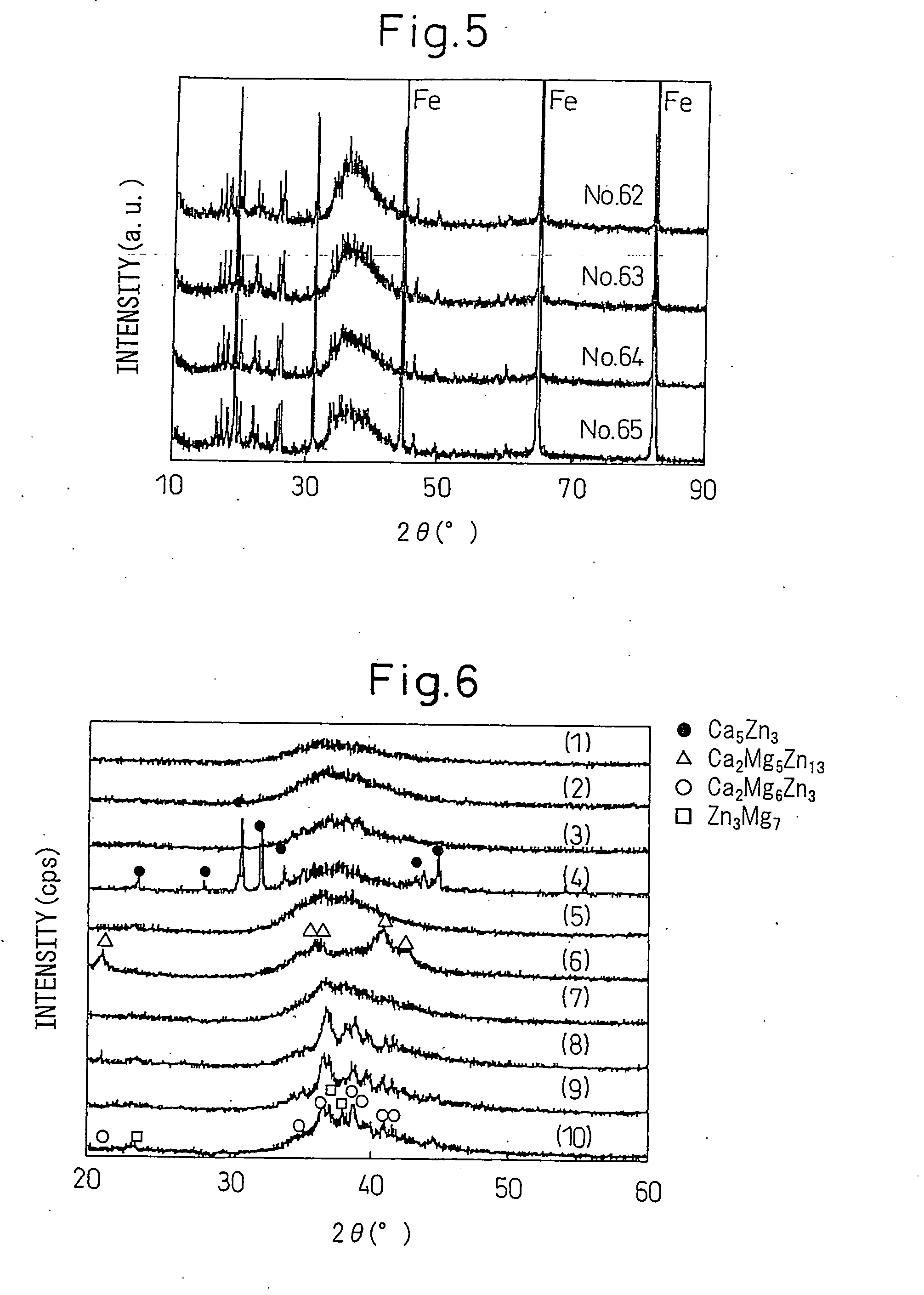Alloy with high glass forming ability and alloy-plated metal material using same
- Summary
- Abstract
- Description
- Claims
- Application Information
AI Technical Summary
Benefits of technology
Problems solved by technology
Method used
Image
Examples
example 1
[0219]Zn, Mg, and Ca metal reagents (purity 99.9 mass % or more) were mixed and melted using a high frequency induction heating furnace in an Ar atmosphere at 600° C., then furnace cooled to obtain a Zn: 50 atm %, Mg: 45 atm %, Ca: 5 atm % chemical composition furnace cooled alloy.
[0220]This furnace cooled alloy had an X-ray diffraction chart as shown in FIG. 1. With this composition, as an equilibrium phase, the intermetallic compound Ca2Mg5Zn13 is formed.
[0221]The alloy of said composition was used to fabricate a thin strip sample by the single roll method. The thin strip sample was fabricated using a Nisshin Giken single roll apparatus (RQ-1).
[0222]A quartz crucible having a slit-shaped aperture (0.6 mm×20 mm) at its bottom end was charged with the alloy to 0.1 kg and heated. The alloy was held at a temperature 100° C. higher than the melting point of 346° C. (619K) for 5 minutes, then the molten alloy was ejected on to a Cu roll (roll diameter 300 mm) rotated at a peripheral spe...
example 2
[0225]Zn, Al, Mg, and Ca metal reagents (purity 99.9 mass % or more) were mixed and melted using a high frequency induction furnace in an Ar atmosphere at 600° C., then furnace cooled to obtain the a furnace cooled alloy of a chemical composition of Zn:45 atm %, Mg:50 atm %, and Ca:5 atm %.
[0226]This alloy was used to fabricate a thin strip sample by the single roll method. For fabrication of the thin strip sample, a single roll apparatus (RQ-1) made by Nisshin Giken was used.
[0227]A quartz crucible having a slit-shaped aperture (0.6 mm×20 mm) at its front end was charged with 0.1 kg of the alloy and heated. The alloy was held at a temperature of 100° C. higher than the melting point 373° C. (646K) for 5 minutes. The molten alloy was ejected at a pressure of 0.03 MPa on a Cu roll (roll diameter 300 mm) rotated at a peripheral speed of 50 m / sec.
[0228]The distance between the aperture and roll surface at the time of ejection was 0.2 mm. The obtained thin strip sample had a width of 3 ...
example 3
[0230]Different metals (purity 99.9 mass % or more) were mixed in predetermined amounts and melted using a high frequency induction heating furnace in an Ar atmosphere at 600 to 1100° C., then were furnace cooled to obtain alloys of the chemical compositions of Nos. 1 to 48 shown in Table 1 and Table 2 (continuation of Table 1).
[0231]The chemical compositions of the different alloys were determined by ICP (inductively-coupled plasma) spectrometry using acid-solution dissolving swarf obtained from the alloys.
[0232]To fabricate amorphous samples of the alloys of the above chemical compositions, the single roll method was used.
[0233]Using an apparatus the same as the one used in Example 1, quartz crucibles having slit-shaped apertures (0.6 mm×20 mm) at their front ends were charged with 0.1 kg amounts of these alloys. The alloys were held at temperatures 80 to 200° C. higher than the melting points (Tm) for several minutes. The molten alloys were ejected at pressures of 0.02 to 0.03 MP...
PUM
| Property | Measurement | Unit |
|---|---|---|
| Fraction | aaaaa | aaaaa |
| Fraction | aaaaa | aaaaa |
| Nanoscale particle size | aaaaa | aaaaa |
Abstract
Description
Claims
Application Information
 Login to View More
Login to View More - R&D
- Intellectual Property
- Life Sciences
- Materials
- Tech Scout
- Unparalleled Data Quality
- Higher Quality Content
- 60% Fewer Hallucinations
Browse by: Latest US Patents, China's latest patents, Technical Efficacy Thesaurus, Application Domain, Technology Topic, Popular Technical Reports.
© 2025 PatSnap. All rights reserved.Legal|Privacy policy|Modern Slavery Act Transparency Statement|Sitemap|About US| Contact US: help@patsnap.com



